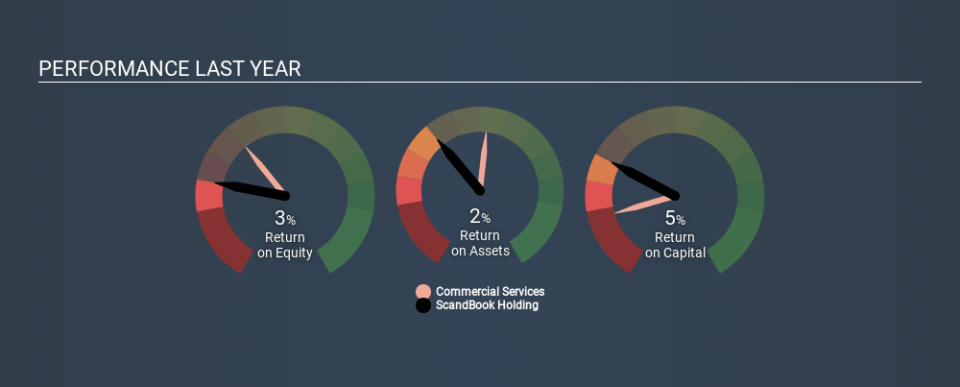Shareholders Should Look Hard At ScandBook Holding AB (publ)’s (STO:SBOK) 4.5%Return On Capital

Today we'll look at ScandBook Holding AB (publ) (STO:SBOK) and reflect on its potential as an investment. Specifically, we're going to calculate its Return On Capital Employed (ROCE), in the hopes of getting some insight into the business.
Firstly, we'll go over how we calculate ROCE. Next, we'll compare it to others in its industry. Then we'll determine how its current liabilities are affecting its ROCE.
What is Return On Capital Employed (ROCE)?
ROCE is a metric for evaluating how much pre-tax income (in percentage terms) a company earns on the capital invested in its business. Generally speaking a higher ROCE is better. Ultimately, it is a useful but imperfect metric. Author Edwin Whiting says to be careful when comparing the ROCE of different businesses, since 'No two businesses are exactly alike.
So, How Do We Calculate ROCE?
Analysts use this formula to calculate return on capital employed:
Return on Capital Employed = Earnings Before Interest and Tax (EBIT) ÷ (Total Assets - Current Liabilities)
Or for ScandBook Holding:
0.045 = kr10m ÷ (kr273m - kr46m) (Based on the trailing twelve months to December 2019.)
So, ScandBook Holding has an ROCE of 4.5%.
View our latest analysis for ScandBook Holding
Is ScandBook Holding's ROCE Good?
ROCE is commonly used for comparing the performance of similar businesses. In this analysis, ScandBook Holding's ROCE appears meaningfully below the 8.1% average reported by the Commercial Services industry. This could be seen as a negative, as it suggests some competitors may be employing their capital more efficiently. Aside from the industry comparison, ScandBook Holding's ROCE is mediocre in absolute terms, considering the risk of investing in stocks versus the safety of a bank account. Readers may find more attractive investment prospects elsewhere.
ScandBook Holding delivered an ROCE of 4.5%, which is better than 3 years ago, as was making losses back then. That implies the business has been improving. You can see in the image below how ScandBook Holding's ROCE compares to its industry. Click to see more on past growth.
When considering ROCE, bear in mind that it reflects the past and does not necessarily predict the future. ROCE can be deceptive for cyclical businesses, as returns can look incredible in boom times, and terribly low in downturns. ROCE is, after all, simply a snap shot of a single year. If ScandBook Holding is cyclical, it could make sense to check out this free graph of past earnings, revenue and cash flow.
What Are Current Liabilities, And How Do They Affect ScandBook Holding's ROCE?
Short term (or current) liabilities, are things like supplier invoices, overdrafts, or tax bills that need to be paid within 12 months. Due to the way ROCE is calculated, a high level of current liabilities makes a company look as though it has less capital employed, and thus can (sometimes unfairly) boost the ROCE. To check the impact of this, we calculate if a company has high current liabilities relative to its total assets.
ScandBook Holding has total assets of kr273m and current liabilities of kr46m. Therefore its current liabilities are equivalent to approximately 17% of its total assets. This is a modest level of current liabilities, which would only have a small effect on ROCE.
The Bottom Line On ScandBook Holding's ROCE
That said, ScandBook Holding's ROCE is mediocre, there may be more attractive investments around. You might be able to find a better investment than ScandBook Holding. If you want a selection of possible winners, check out this free list of interesting companies that trade on a P/E below 20 (but have proven they can grow earnings).
If you like to buy stocks alongside management, then you might just love this free list of companies. (Hint: insiders have been buying them).
If you spot an error that warrants correction, please contact the editor at editorial-team@simplywallst.com. This article by Simply Wall St is general in nature. It does not constitute a recommendation to buy or sell any stock, and does not take account of your objectives, or your financial situation. Simply Wall St has no position in the stocks mentioned.
We aim to bring you long-term focused research analysis driven by fundamental data. Note that our analysis may not factor in the latest price-sensitive company announcements or qualitative material. Thank you for reading.


